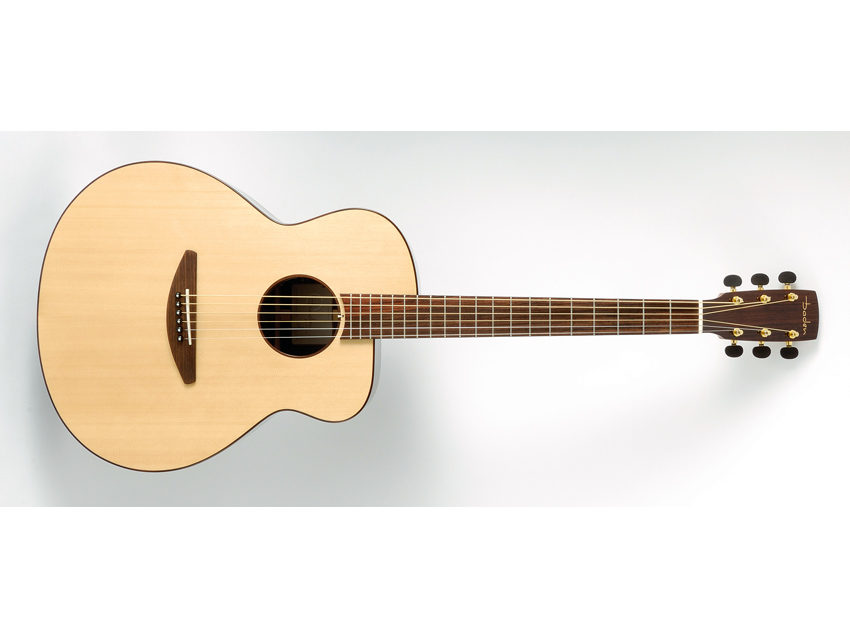MusicRadar Verdict
An engagingly new and intriguing perspective on what constitutes an A-style instrument.
Pros
- +
Looks; neck; sound; ultra-tidy build.
Cons
- -
Sample's iffy string output balance is a powered irritation.
MusicRadar's got your back

A cutaway with a twist.

The A-Style's treble bout appears as though it has been dropped down about 6cm.
The A-Style Rosewood Ellipse Aura created a stir at March's Frankfurt Musikmesse, where the Badens had their European launch.
It's not altogether surprising because although the asymmetric body shape in effect provides a cutaway, it doesn't do so in the normal manner.
Overview
It's like the treble-side upper bout has been dropped down (approximately six centimetres) from the neck join, and peering inside the body reveals that the rim and kerfed linings on that side continue across the face of the neckblock rather than simply butting up to it.
Another unusual, if more prosaic, aspect is that although based on a mid-size auditorium, its sides are dreadnought-like in depth - at 118mm only one mm less than the dreadnought D-Style's. This is still a capacious soundbox, then.
As the model name signifies, the back and sides are Indian rosewood and, following the Baden house style, these are matched by the same timber for the rosette and body bindings with the latter's light-wood rim purfling providing more of a visual contrast against the dark wood than it does on the D-Style's light-coloured mahogany.
The hardware, cosmetic trim (keystone included), ancillary timbers and finish are otherwise largely identical, the only obvious difference being a set of gold tuners with ebony buttons, rather than the D's all-chrome jobs.
Save for a darker stain under the satin lacquer and a smidge less depth near the nut, the neck has a similar spec and profile to the dreadnought's and is an equally obliging player.
For its electros, Baden uses Fishman's Ellipse Aura blender system: a simplified, non-invasive soundhole version of the rimmounted Onboard Aura. Instead of the Onboard's six editable, fully EQ'able sound images, the Ellipse has four presets and the only variable EQ is a bass-boost switch.
For practical reasons the Ellipse sacrifices the Onboard's tuner but does include the same preamp level trimpot and switchable, feedback searchand-destroy facility.
This could be used on the hoof but the buttonpressing procedure and internally located controls mean it's more viable to set it up in advance of a performance by provoking the guitar into feedback and letting the circuitry do its stuff. It works.
For real-time adjustments, the sliders and other switches fall easily enough under a fingertip once you've familiarised where they are on the panel.
Sounds
Unsurprisingly, given its deep body, this A-Style concedes little or nothing to the dreadnought for outright acoustic punch, which is generous.
Tonally, the differences are more complex. It lacks some of the D-Style's sweetly supple follow-through, and actually has an edgier attack which initially gives the impression of a brighter, slightly harder sound.
Yet sitting underneath - something you'd expect from rosewood back and sides - is a subtly deeper and darker bass response, particularly from the bottom E. The overall effect is to lend a shade more expressiveness to picking styles, yet not possess quite the same fluidity for strumming.
In an auditorium-guitar context, where fingerstyle is much higher up on the agenda, that's not an unreasonable outcome.
Compared to real-mic blender systems, the Ellipse Aura is a lot more controllable, allowing higher ratios of image to undersaddle pickup before the ambience starts to sound unnatural or unduly feedback prone.
In practice, however, we'd expect many users will still rely mainly on the under-saddle sound -
which is very good - adding only a modest percentage of image according to the playing circumstances. Which image is preferred is entirely a matter of personal taste.
So, a versatile showing on this A-Style, marred by just one thing - our sample's inter-string output is imbalanced with a dominant bottom E and a shy G.
This sort of thing is frustratingly common with under-saddle systems, and since the Matrix pickup triggers the image signal as well as generating the pickup sound, the imbalance can be heard via both sources.
It's not the end of the world and is easily rectifiable by a decent guitar tech, however it does somewhat undermine what would otherwise be an impressive powered performance.

"It’s a piece of music software history": ReCycle gets recycled as Reason Studios makes the classic sample editor available as a free download

“The verse tricks you into thinking that it’s in a certain key and has this ‘simplistic’ musical language, but then it flips”: Charli XCX’s Brat collaborator Jon Shave on how they created Sympathy Is A Knife

“I’ve seen a million faces and I’ve rocked them all!”: Was Bon Jovi’s 1989 acoustic performance really the inspiration for MTV Unplugged?










